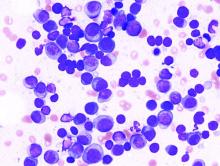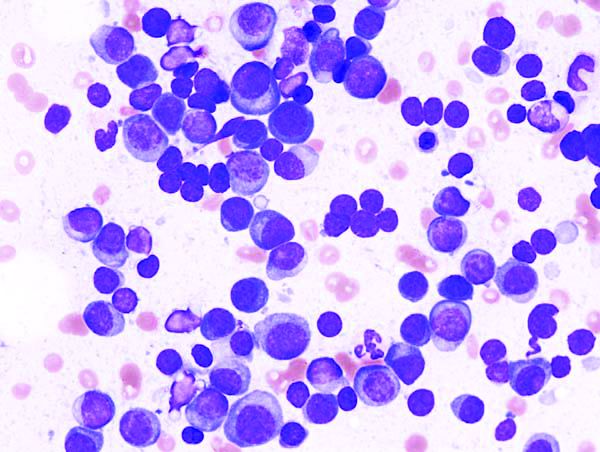User login
For patients with multiple myeloma in relapse after an autologous stem cell transplant (ASCT), salvage ASCT is associated with reduced quality of life and greater pain in the near term, compared with nontransplantation consolidation (NTC) therapy, a secondary analysis from the United Kingdom’s Myeloma X trial suggested.
But global health status scores for salvage ASCT (sASCT) lagged only in the first 100 days after randomization, whereas pain scores were worse with salvage transplantation in the first 2 years but slightly better thereafter, reported Sam H. Ahmedzai, MBChB, from the University of Sheffield, England, and his colleagues.
“The small and diminishing differences in global health status and side effects of treatment need to be considered alongside the results of Myeloma X, which showed a significant benefit of sASCT on [overall survival]. The benefits of sASCT should be considered alongside the relatively short-term negative effects on [quality of life] and pain when making patient treatment decisions and further support the use of sASCT,” they wrote in the Journal of Clinical Oncology.
The BSBMT/UKMF Myeloma X trial was a multicenter, randomized, phase 3 trial comparing sASCT with weekly oral cyclophosphamide in patients with multiple myeloma who had relapsed after a prior ASCT. In the final overall survival analysis, median overall survival was superior for the sASCT, at 67 months vs. 52 months for nontransplantation consolidation (P = .022; hazard ratio, 0.56; P = .0169).
In the current study, the investigators reported on secondary patient-reported pain and quality of life outcomes assessed using the validated European Organization for Research and Treatment of Cancer Questionnaire (QLQ-C30) and its myeloma-specific module, QLQ-MY20; the Brief Pain Inventory (Short Form), and the Leeds Assessment of Neuropathic Symptoms and Signs (Self-Assessment) scale.
Of the 297 patients enrolled, 288 had consented to the quality of life portion of the study, and of this group, 171 (88 assigned to sASCT and 83 assigned to NTC) were included.
After a median follow-up of 52 months, the QLQ-C30 global health status scores were 9.2 points higher (indicating better) for patients in the nontransplantation group (P = .0496) at 100 days after transplantation, but there were no significant differences between the groups for this measure at any later time point.
“This deterioration in global health status for patients receiving sASCT, compared with NTC, dissipated to a trivial difference at 6 months and a smaller trivial difference at 1 year,” Dr. Ahmedzai and his colleagues wrote.
At 2 years, the pendulum had swung to favor sASCT, but also by a “trivial” amount.
The side effects of treatment subscale was slightly higher (worse) with sASCT at 100 days and 6 months after treatment, but this difference dwindled thereafter.
Pain interference scores adjusted for baseline score and baseline neuropathic pain level were not significantly different 100 days after randomization, but there were significant differences at both 6 months and up to 2 years. At all the time points considered, pain interference scores were approximately 1 point lower in the NTC group, which the authors noted is a clinically relevant difference.
Patients who had undergone sASCT and reported below-median scores on a side-effect subscale had significantly longer time to progression, compared with patients who received NTC (HR, 0.24; P = .003), a difference that held up on multivariable regression analysis (HR, 0.20; P = .0499).
Pain scores were not significantly predictive of either time to progression or overall survival, however.
The study was supported by Cancer Research UK, Janssen-Cilag, and Chugai Pharma UK. Dr. Ahmedzai reported honoraria, consulting, research funding, and travel fees from various companies, not including the study sponsors.
SOURCE: Ahmedzai SH et al. J Clin Oncol. 2019 Apr 10. doi: 10.1200/JCO.18.01006.
For patients with multiple myeloma in relapse after an autologous stem cell transplant (ASCT), salvage ASCT is associated with reduced quality of life and greater pain in the near term, compared with nontransplantation consolidation (NTC) therapy, a secondary analysis from the United Kingdom’s Myeloma X trial suggested.
But global health status scores for salvage ASCT (sASCT) lagged only in the first 100 days after randomization, whereas pain scores were worse with salvage transplantation in the first 2 years but slightly better thereafter, reported Sam H. Ahmedzai, MBChB, from the University of Sheffield, England, and his colleagues.
“The small and diminishing differences in global health status and side effects of treatment need to be considered alongside the results of Myeloma X, which showed a significant benefit of sASCT on [overall survival]. The benefits of sASCT should be considered alongside the relatively short-term negative effects on [quality of life] and pain when making patient treatment decisions and further support the use of sASCT,” they wrote in the Journal of Clinical Oncology.
The BSBMT/UKMF Myeloma X trial was a multicenter, randomized, phase 3 trial comparing sASCT with weekly oral cyclophosphamide in patients with multiple myeloma who had relapsed after a prior ASCT. In the final overall survival analysis, median overall survival was superior for the sASCT, at 67 months vs. 52 months for nontransplantation consolidation (P = .022; hazard ratio, 0.56; P = .0169).
In the current study, the investigators reported on secondary patient-reported pain and quality of life outcomes assessed using the validated European Organization for Research and Treatment of Cancer Questionnaire (QLQ-C30) and its myeloma-specific module, QLQ-MY20; the Brief Pain Inventory (Short Form), and the Leeds Assessment of Neuropathic Symptoms and Signs (Self-Assessment) scale.
Of the 297 patients enrolled, 288 had consented to the quality of life portion of the study, and of this group, 171 (88 assigned to sASCT and 83 assigned to NTC) were included.
After a median follow-up of 52 months, the QLQ-C30 global health status scores were 9.2 points higher (indicating better) for patients in the nontransplantation group (P = .0496) at 100 days after transplantation, but there were no significant differences between the groups for this measure at any later time point.
“This deterioration in global health status for patients receiving sASCT, compared with NTC, dissipated to a trivial difference at 6 months and a smaller trivial difference at 1 year,” Dr. Ahmedzai and his colleagues wrote.
At 2 years, the pendulum had swung to favor sASCT, but also by a “trivial” amount.
The side effects of treatment subscale was slightly higher (worse) with sASCT at 100 days and 6 months after treatment, but this difference dwindled thereafter.
Pain interference scores adjusted for baseline score and baseline neuropathic pain level were not significantly different 100 days after randomization, but there were significant differences at both 6 months and up to 2 years. At all the time points considered, pain interference scores were approximately 1 point lower in the NTC group, which the authors noted is a clinically relevant difference.
Patients who had undergone sASCT and reported below-median scores on a side-effect subscale had significantly longer time to progression, compared with patients who received NTC (HR, 0.24; P = .003), a difference that held up on multivariable regression analysis (HR, 0.20; P = .0499).
Pain scores were not significantly predictive of either time to progression or overall survival, however.
The study was supported by Cancer Research UK, Janssen-Cilag, and Chugai Pharma UK. Dr. Ahmedzai reported honoraria, consulting, research funding, and travel fees from various companies, not including the study sponsors.
SOURCE: Ahmedzai SH et al. J Clin Oncol. 2019 Apr 10. doi: 10.1200/JCO.18.01006.
For patients with multiple myeloma in relapse after an autologous stem cell transplant (ASCT), salvage ASCT is associated with reduced quality of life and greater pain in the near term, compared with nontransplantation consolidation (NTC) therapy, a secondary analysis from the United Kingdom’s Myeloma X trial suggested.
But global health status scores for salvage ASCT (sASCT) lagged only in the first 100 days after randomization, whereas pain scores were worse with salvage transplantation in the first 2 years but slightly better thereafter, reported Sam H. Ahmedzai, MBChB, from the University of Sheffield, England, and his colleagues.
“The small and diminishing differences in global health status and side effects of treatment need to be considered alongside the results of Myeloma X, which showed a significant benefit of sASCT on [overall survival]. The benefits of sASCT should be considered alongside the relatively short-term negative effects on [quality of life] and pain when making patient treatment decisions and further support the use of sASCT,” they wrote in the Journal of Clinical Oncology.
The BSBMT/UKMF Myeloma X trial was a multicenter, randomized, phase 3 trial comparing sASCT with weekly oral cyclophosphamide in patients with multiple myeloma who had relapsed after a prior ASCT. In the final overall survival analysis, median overall survival was superior for the sASCT, at 67 months vs. 52 months for nontransplantation consolidation (P = .022; hazard ratio, 0.56; P = .0169).
In the current study, the investigators reported on secondary patient-reported pain and quality of life outcomes assessed using the validated European Organization for Research and Treatment of Cancer Questionnaire (QLQ-C30) and its myeloma-specific module, QLQ-MY20; the Brief Pain Inventory (Short Form), and the Leeds Assessment of Neuropathic Symptoms and Signs (Self-Assessment) scale.
Of the 297 patients enrolled, 288 had consented to the quality of life portion of the study, and of this group, 171 (88 assigned to sASCT and 83 assigned to NTC) were included.
After a median follow-up of 52 months, the QLQ-C30 global health status scores were 9.2 points higher (indicating better) for patients in the nontransplantation group (P = .0496) at 100 days after transplantation, but there were no significant differences between the groups for this measure at any later time point.
“This deterioration in global health status for patients receiving sASCT, compared with NTC, dissipated to a trivial difference at 6 months and a smaller trivial difference at 1 year,” Dr. Ahmedzai and his colleagues wrote.
At 2 years, the pendulum had swung to favor sASCT, but also by a “trivial” amount.
The side effects of treatment subscale was slightly higher (worse) with sASCT at 100 days and 6 months after treatment, but this difference dwindled thereafter.
Pain interference scores adjusted for baseline score and baseline neuropathic pain level were not significantly different 100 days after randomization, but there were significant differences at both 6 months and up to 2 years. At all the time points considered, pain interference scores were approximately 1 point lower in the NTC group, which the authors noted is a clinically relevant difference.
Patients who had undergone sASCT and reported below-median scores on a side-effect subscale had significantly longer time to progression, compared with patients who received NTC (HR, 0.24; P = .003), a difference that held up on multivariable regression analysis (HR, 0.20; P = .0499).
Pain scores were not significantly predictive of either time to progression or overall survival, however.
The study was supported by Cancer Research UK, Janssen-Cilag, and Chugai Pharma UK. Dr. Ahmedzai reported honoraria, consulting, research funding, and travel fees from various companies, not including the study sponsors.
SOURCE: Ahmedzai SH et al. J Clin Oncol. 2019 Apr 10. doi: 10.1200/JCO.18.01006.
FROM THE JOURNAL OF CLINICAL ONCOLOGY

